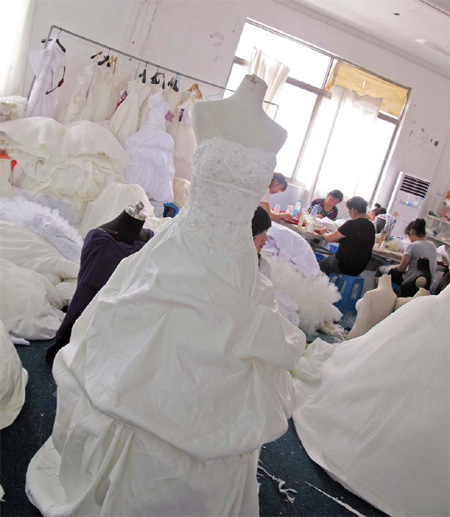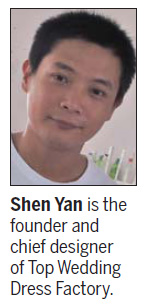Economy
Say yes to the wedding dress
Updated: 2011-08-12 11:26
(China Daily European Weekly)
|
 Chinese wedding dress makers used to produce to export, but more of them are shifting to the domestic market. Yan Yiqi / China Daily
|
More Chinese women are purchasing gowns for their big days
On the third floor of a tile-roofed house at the end of a nondescript alley in Suzhou, six young women sit at computers taking orders from around the world. In an adjacent room, sewing machines hum as white wedding gowns come off the production line in the 30-square-meter workshop. Shen Yan, founder and chief designer of the Top Wedding Dress Factory, says the workshop produces up to 1,200 dresses a month, at an average price of 1,000 yuan (109 euros). Once they are hanging in a Western wedding dress shop, three or four weeks later, they will have a price tag of at least $1,000 (709 euros).
In the Huqiu district of Suzhou, eastern China, at least 1,000 such factories have sprung up. They sell wedding dresses online, and almost all their customers are from overseas.
"We have online shops on all mainstream business-to-customer platforms like cn.made-in-china.com, Dhgate.com and eBay," Shen says. "Most of our clients are from Britain, the United States and Russia."
Just type "wedding dress" into the search engine of DHgate.com, one of the largest business-to-consumer platforms connecting overseas buyers with Chinese sellers, and more than 468,000 entries pop up.
After ordering and paying, most customers will have their dresses in 25-35 days.
DHgate.com claims it handled orders worth more than $10 million last year, most of the customers being from developed countries, including the US and Europe.
"Almost 80 percent of the world's wedding dresses are from China, and Suzhou produces 80 percent of that," says Chen Weijin, chief editor of hsw365.com, said to have the largest number of users among China's wedding dress websites.
"Apart from the very expensive high-end ones, it is hard to find a wedding dress not made in China," Chen says.
Exports account for virtually all of the business of the 20,000 or so wedding dress companies in China, Chen says.
"Without exaggeration, almost all companies rely on overseas markets," Chen says. "There are companies that do business in the domestic market, but about 95 percent of them still focus on overseas markets."
There is little doubt about what attracts the companies to overseas markets: higher profits.
"An average wedding dress in China costs no more than 500-600 yuan, but our products can be sold as high as 1,000 yuan overseas," says Liu Tianren, general manager of Suzhou Yaoyi Wedding Dress Company.
Liu's company, with about 60 employees, makes 30 to 40 wedding
|
 |
"When we sell to domestic customers we need a physical shop, which costs a huge amount," Liu says.
"But for overseas business, with everything done online, all we need is a computer and the Internet."
Shen of Top Wedding Dress attributes the lack of sales at home to the lack of a wedding dress culture.
"Most Chinese would rather rent a wedding dress because they won't be wearing it for a second time. This has largely kept down the demand for wedding dresses in China."
But Shen and other wedding dress makers may be missing out on a huge market.
The deputy secretary-general of Suzhou Wedding Dress Association, Lu Ming, says that with improved living standards and people's minds opening to Western culture, an increasing number of brides are choosing to buy wedding dresses.
The country's largest congregation of wedding dress retailers is in the Huqiu district of Suzhou, and more than 2,000 visitors flock to their stores every day in the busiest periods.
In the Huqiu store of Knightly Wedding Dress, one of the leading wedding dress companies in China, turnover averages 600,000 yuan to 700,000 yuan a month, says Tan Jinjiao, its sales manager.

Specials

Star journalist leaves legacy
Li Xing, China Daily's assistant editor-in-chief and veteran columnist, died of a cerebral hemorrhage on Aug 7 in Washington DC, US.

Beer we go
Early numbers not so robust for Beijing's first international beer festival

Lifting the veil
Beijing's Palace Museum, also known as the Forbidden City, is steeped in history, dreams and tears, which are perfectly reflected in design.